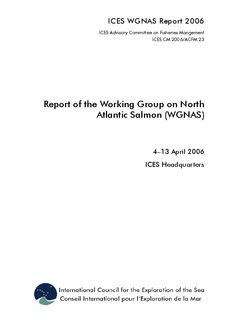| dc.contributor.author | ICES | |
| dc.date.accessioned | 2007-07-27T12:02:08Z | |
| dc.date.issued | 2006 | |
| dc.identifier.citation | This report is not to be quoted without prior consultation with the General Secretary. | |
| dc.identifier.uri | http://hdl.handle.net/11250/100939 | |
| dc.description | Contributor: Marianne Holm | |
| dc.description.abstract | • Exploitation continued to decline and nominal catch of Atlantic salmon in 2005 was
the lowest in the time series
• Marine survival indices suggest that natural mortality remains high
• North American Commission 2SW stock complex is suffering reduced reproductive
capacity
• In the North American Commission area, factors other than fisheries are contributing
to continued low adult abundance
• Northern North East Atlantic Commission stock complexes (1SW and MSW) are at
risk of suffering reduced reproductive capacity
• Southern North East Atlantic Commission stock complexes (1SW and MSW) are
suffering reduced reproductive capacity
• There are no catch options for the 2006–2008 fisheries at West Greenland and the
Faroes that would allow the stated precautionary management objectives to be met | en |
| dc.format.extent | 2696729 bytes | |
| dc.format.mimetype | application/pdf | |
| dc.language.iso | eng | en |
| dc.publisher | ICES | en |
| dc.relation.ispartofseries | ICES CM documents | en |
| dc.relation.ispartofseries | 2006/ACFM:23 | en |
| dc.subject | atlantisk laks | en |
| dc.subject | atlantic salmon | en |
| dc.title | Report of the Working Group on North Atlantic Salmon (WGNAS) [4-13 April 2006 ICES Headquarters] | en |
| dc.type | Working paper | en |
| dc.subject.nsi | VDP::Agriculture and fishery disciplines: 900::Fisheries science: 920::Resource biology: 921 | |
| dc.subject.nsi | VDP::Agriculture and fishery disciplines: 900::Fisheries science: 920::Catch: 925 | |
| dc.source.pagenumber | 262 s. | en |
